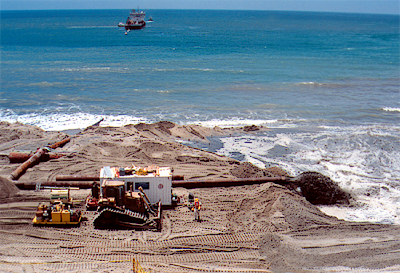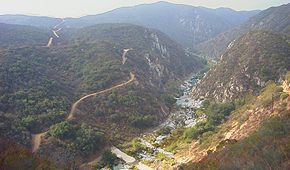New Sand Sources
 inding more sand for southern California's beaches will require innovation to tap new sand sources as well as protection of remaining sources.
inding more sand for southern California's beaches will require innovation to tap new sand sources as well as protection of remaining sources.
Develop new technologies for beach nourishment
- Bypass sand around dams
Millions of cubic meters of sand are trapped behind dams in coastal basins of southern California. This valuable source of beach sand is largely untapped, and the technology exists to bypass sand around a dam and deliver it to the coast. Bypassing sand also improves the performance and lifespan of the dams.
- Remove dams
For more information:
• Nature waits on fate of dam
"The Matilija structure and others
like it are targeted for removal
to restore U.S. rivers."Another approach is simply to remove the dams that have outlived their usefulness. Matilija Dam on a tributary of the Ventura River in the Santa Barbara cell is scheduled for demolition. This dam trapped 4.6 million cubic meters (6 million cubic yd) of sediment that will be released to the littoral cell. If federal funding to cover 65% of the project's cost is included in appropriations for fiscal year 2005, demolition could begin in 2006 with completion expected within two years.
- Restore wetlands and recycle sand to the beach
Coastal lagoons store millions of cubic meters of sand. In-filling of lagoons with sediment has resulted in the loss of tidal circulation and open water habitat. New methods could be developed to restore tidal circulation and wetlands habitat while yielding sand for downcoast beaches.
-
Pump shelf sand to the beach
Offshore sand sources suitable for beach replenishment have been identified in southern California. Drowned stream valleys and submarine terraces contain large deposits of sand. The cost of dredging and pumping sand back to the beach has been successfully overcome in regional beach nourishment projects.
Beach nourishment project South Carlsbad State Beach in July 2001.
As part of the Regional Beach Sand Project, 158,000 cubic yards of sand were placed at this beach. Fill length was 2,000 feet, berm width 180 feet, berm elevation was +12 and cost was $4.39 per cubic yard. SANDAG was sponsor, Noble Consultants was the engineer, and NATCO Limited Partnership was the construction contractor. Image courtesy SANDAG.
- Find new sand sources on the nearshore shelf
- In addition, new generation seismic surveying equipment such as Chirp provide high resolution views of sand reservoirs in shallow water depth on the inner shelf. These reservoirs can be dredged more economically than deeper water deposits.
- Recycle sand from submarine canyons
- The sinks of sediment for most southern California littoral cells are submarine canyons. Once it enters the canyons, sand is permanently lost to the littoral cell. With the appropriate environmental safeguards, it should be possible to dam the heads of submarine canyons and dredge the accumulated sand for beach nourishment. This technology would retrieve sand before it is transported into the deep ocean basins.
 Santa Margarita River. Photograph courtesty HPWren - http://hpwren.ucsd.edu. Image used with permission.
"What is needed is a body of laws and regulations that will protect the right of sand to travel and migrate along the coast so that long-term coastal shoreline solutions will be assured..."
- from Magoon and Edge,Sand Rights: The Fragile Coastal Balance |
Natural watersheds are nearly extinct in southern California so it becomes even more critical to preserve sediment transport potential within high-yield basins such as the San Luis Rey and Santa Clara Rivers. Just as we understand the value of maintaining open space -- habitat preservation, wildlife protection, water quality, scenic beauty, and recreation -- maintaining sand transport to the coast must become an equally important environmental goal. The long-term costs of artificial beach replenishment should be factored in to the environmental costs of development within coastal watersheds. |
©2002-2004 by the Regents of the University of California and the Kavli Institute.
All rights reserved.
Last modifed Thursday September 23, 2004

